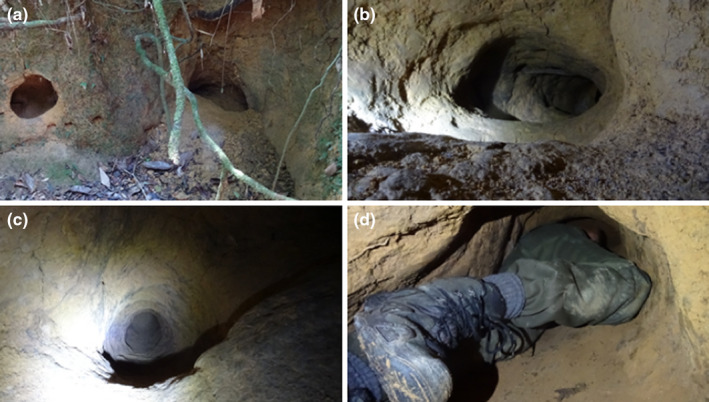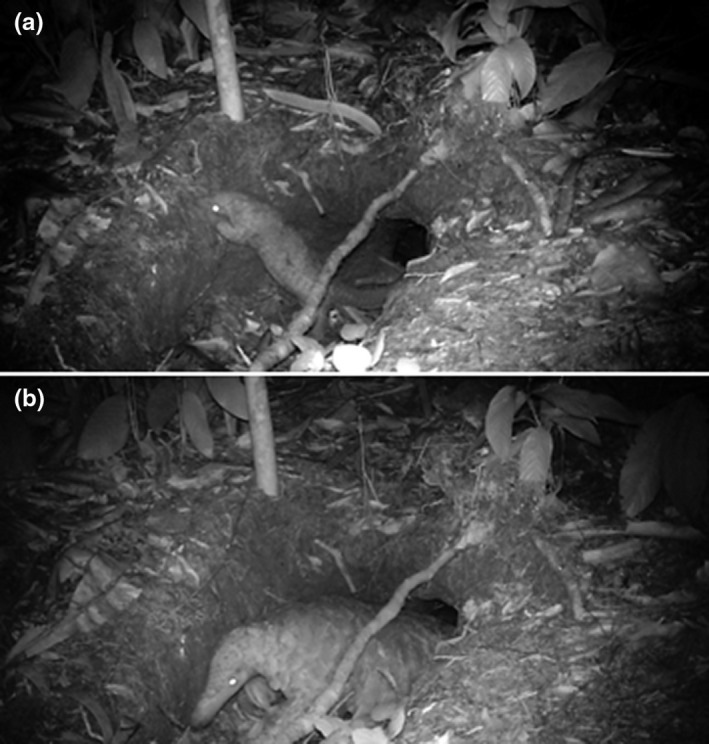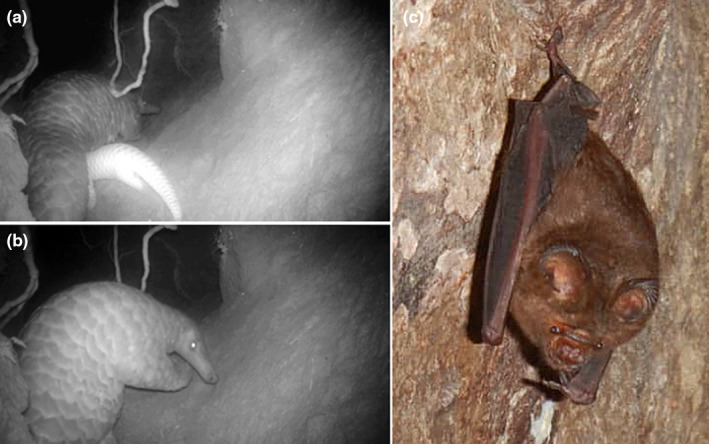1. INTRODUCTION
In light of recent publications (e.g. Lam et al., 2020; Shang et al., 2020) that indicate a link between pangolin and bat coronaviruses related to SARS‐CoV‐2 (severe acute respiratory syndrome coronavirus 2), we believe that recent observations of pangolins and bats sharing burrows in Lopé, Central Gabon, is of general interest. Our observations were made during an ecological and spatial movement study of the giant pangolin, Smutsia gigantea.
2. METHODS
We used direct animal tracking, telemetry and 30 camera traps to study a mature male giant pangolin in the northern part of Lopé National Park in late 2019. We incidentally recorded the movement and behaviour of other individuals using the same territory. Individuals could be recognised by scale pattern and size. On 10 occasions, two individuals were filmed simultaneously. The different located burrows used by the focal male were also thoroughly visually inspected.
3. RESULTS AND DISCUSSION
3.1. Burrow architecture
The burrows consist of complex, interlacing underground networks with up to 10 concealed entrances dug out between large roots and rocks (Figure 1). They span up to 75 m2, are up to 4 m deep and tunnels are up to 30 m long (Figure 1). Galleries intersect to form large ovoid resting chambers.
FIGURE 1.

In (a) two of the 10 entrances of a giant pangolin burrow complex; in (b) a vertical gallery (50–100 cm wide, 20 m long and 3 m steep); in (c) a transversal gallery (40–100 cm wide; >25 m long); and in (d) team leader for scale
3.2. Giant pangolin burrowing behaviour
The focal male ranges over 38 km2 of savannah, gallery forest, forest fragments, secondary and mature tropical rain forest. We identified twelve different sleeping sites in gallery and forest fragments that are regularly used by the focal male, nine of which are burrow systems and three are hollow trees. Preliminary telemetry data suggest several more potential burrows exist in mature forest but these have not yet been inspected visually.
Seven of the 12 burrows were frequently visited by at least one smaller male. Three of them were used by two different pangolin females with infants that were never observed together. Six of the burrows were frequently visited by a large lone female; with whom the male was observed walking, feeding and interacting during successive nights. Burrows were rarely used on two successive nights. Two hollow trees were occasionally visited.
3.3. Species using the burrows
These galleries also provide shelter for other animal species. We observed the presence of African rock pythons (Python sebae) in two burrows. One python used a burrow as a nest. The giant pangolin co‐occurred in this burrow but rested in a separate chamber.
Brush‐tailed porcupine Atherurus africanus and white‐bellied pangolin Phataginus tricuspis opportunistically occupied giant pangolin burrows (Figure 2), more frequently when the pangolin was not simultaneously present. At night, small rodents Rodentia, genets Genetta sp. and mongooses (e.g. marsh mongoose Atilax paludinosus) species are also often seen in burrows.
FIGURE 2.

(a) White‐bellied (Phataginus tricuspis) and (b) giant (Smutsia gigantea) pangolins emerging from the same burrow
We observed at least three different species of Microchiroptera bats roosting inside nine of the investigated burrows Hipposideridae sp., Emballonuridae sp. and Miniopterus sp. (Figure 3). They usually hang in small group from the ceiling of large galleries and empty resting chambers. On one occasion, we disturbed a single individual fruit bat Micropteropus sp. Bat faeces and traces of guano were observed in eleven of the twelve sleeping sites. We captured numerous videos of pangolins and unidentified bats emerging from the same burrow at the same time. At least two unidentified bat species roosted in one of the hollow trees. We therefore assumed that all sleeping sites accommodate bat species.
FIGURE 3.

(a) Female and infant giant pangolin; (b) our focal male and (c) Hipposideros ruber are observed using the same burrow
3.4. Promiscuity and viruses
Bats are considered to be the reservoir of many emerging virulent viruses, highly pathogenic for humans, such as SARS coronaviruses (CoV) (Hu et al., 2017; Wang et al., 2018), Ebola virus and Marburg virus (Maganga et al., 2011). In Gabon, previous studies highlighted the cocirculation of Ebola and Marburg viruses in bat populations, with a high seroprevalence of both viruses in fruit bats (Maganga et al., 2011; Pourrut et al., 2009). Furthermore, Miniopterus inflatus, Hipposideros ruber and Coleura afra were found carrying novel species of Astrovirus (Rougeron et al., 2016). Ultimately, Hipposideros ruber were found infected with CoVs (Maganga et al., 2020). Lam et al. (2020) found recombination signals between Malayan pangolins, Manis javanica coronaviruses, bat coronaviruses RaTG13 and human SARS‐CoV‐2.
4. CONCLUSION
The fact that both giant and white‐bellied pangolins in Lopé, Central Gabon, use burrows that are inhabited by several species of bats illustrates that there is frequent opportunity for pangolins to be exposed to bat‐borne viruses. Pangolins are also commonly found in game meat markets in Gabon and are sometimes sold alive (Ingram et al., 2017; Mambeya et al., 2018) demonstrating risk of viral infection to humans. Until the links between bat, pangolin and human coronaviruses are better understood we suggest that Gabon takes steps to stop people capturing, handling or eating wild bats or wild pangolins. In this respect, wildlife researchers should conduct a detailed serological survey of the giant pangolin burrow's ecosystem.
CONFLICT OF INTEREST
Lee White is a minister in the Gabonese Government.
ACKNOWLEDGEMENTS
This work was undertaken at the Station d' Etudes des Gorilles et des Chimpanzés (SEGC) in Lopé National Park, run by the Agence Nationale des Parcs Nationaux (ANPN). Funding was from ANPN, Total Gabon Vert and the ECOFAC 6 program of the European Union. We thank CENAREST and ANPN for delivering permit n°AR/0038/19. Dr. Whytock is funded by UKRI‐GCRF Trade Hub.
Lehmann D, Halbwax ML, Makaga L, et al. Pangolins and bats living together in underground burrows in Lopé National Park, Gabon. Afr J Ecol. 2020;58:540–542. 10.1111/aje.12759
DATA AVAILABILITY STATEMENT
Data are available at the Agence Nationale des Parcs Nationaux du Gabon.
REFERENCES
- Hu, B. , Zeng, L.‐P. , Yang, X.‐L. , Ge, X.‐Y. , Zhang, W. , Li, B. , … Shi, Z.‐L. (2017). Discovery of a rich gene pool of bat SARS‐related coronaviruses provides new insights into the origin of SARS coronavirus. PLOS Pathogens, 13(11), e1006698. 10.1371/journal.ppat.1006698 [DOI] [PMC free article] [PubMed] [Google Scholar]
- Ingram, D. J. , Coad, L. , Abernethy, K. A. , Maisels, F. , Stokes, E. J. , Bobo, K. S. , … Scharlemann, J. P. W. (2017). Assessing Africa‐wide pangolin exploitation by scaling local data: assessing african pangolin exploitation. Conservation Letters, 11(2), e12389. 10.1111/conl.12389 [DOI] [Google Scholar]
- Lam, T. T. , Shum, M. H. , Zhu, H. , Tong, Y. , Ni, X. , Liao, Y. , … Guan, Y. (2020). Identifying SARS‐CoV‐2 related coronaviruses in Malayan pangolins. Nature. 10.1038/s41586-020-2169-0 [DOI] [PubMed] [Google Scholar]
- Maganga, G. D. , Bourgarel, M. , Ebang Ella, G. , Drexler, J. F. , Gonzalez, J. P. , Drosten, C. , & Leroy, E. M. (2011). Is Marburg virus enzootic in Gabon? The Journal of Infectious Diseases, 204(suppl_3), S800–S803. [DOI] [PubMed] [Google Scholar]
- Maganga, G. D. , Pinto, A. , Mombo, I. , Madjitobaye, M. , Mbeang Beyeme, A. M. , Boundenga, L. , … Leroy, M. E. (2020). Genetic diversity and ecology of coronaviruses hosted by cave‐dwelling bats in Gabon. Scientific Report, 10, 7314. 10.1038/s41598-020-64159-1 [DOI] [PMC free article] [PubMed] [Google Scholar]
- Mambeya, M. M. , Baker, F. , Momboua, B. R. , Koumba Pambo, A. F. , Hega, M. , Okouyi Okouyi, V. J. , … Abernethy, K. (2018). The emergence of a commercial trade in pangolins from Gabon. African Journal of Ecology, 56(3), 601–609. 10.1111/aje.12507 [DOI] [Google Scholar]
- Pourrut, X. , Souris, M. , Towner, J. S. , Rollin, P. E. , Nichol, S. T. , Gonzalez, J. P. , & Leroy, E. (2009). Large serological survey showing cocirculation of Ebola and Marburg viruses in Gabonese bat populations, and a high seroprevalence of both viruses in Rousettus aegyptiacus . BMC Infectious Diseases, 9(1), 159. 10.1186/1471-2334-9-159 [DOI] [PMC free article] [PubMed] [Google Scholar]
- Rougeron, V. , Suquet, E. , Maganda, G. D. , Jiolle, D. , Mombo, I. M. , Bourgarel, M. , & Leroy, E. M. (2016). Characterization and phylogenetic analysis of new bat astroviruses detected in Gabon, Central Africa. Acta Virologica, 60, 386–392. [DOI] [PubMed] [Google Scholar]
- Shang, J. , Ye, G. , Shi, K. E. , Wan, Y. , Luo, C. , Aihara, H. , … Li, F. (2020). Structural basis of receptor recognition by SARS‐CoV‐2. Nature, 581(7807), 221–224. 10.1038/s41586-020-2179-y [DOI] [PMC free article] [PubMed] [Google Scholar]
- Wang, N. , Li, S. Y. , Yang, X. L. , Huang, H. M. , Zhang, Y. J. , Guo, H. , … Hagan, E. (2018). Serological evidence of bat SARS‐related coronavirus infection in humans, China. Virologica Sinica, 33(1), 104–107. [DOI] [PMC free article] [PubMed] [Google Scholar]
Associated Data
This section collects any data citations, data availability statements, or supplementary materials included in this article.
Data Availability Statement
Data are available at the Agence Nationale des Parcs Nationaux du Gabon.


